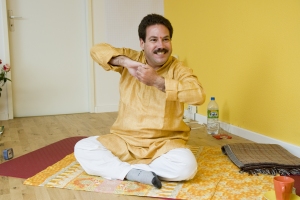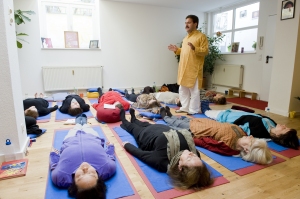By Yogacharya Dr. Ananda Balayogi Bhavanani
Dr. Ananda is one of our amazing guest writers. He is the chairman of the ICYER (International Centre for Yoga Education and Research) Ananda Ashram in Pondicherry, India. You can find more information about him in our guest writer post or on his websites: www.icyer.com, www.rishiculture.org.

Yoga as a mode of therapy (yoga chikitsa) has become extremely popular, and a great number of studies and systematic reviews offer scientific evidence of its potential in treating a wide range of psychosomatic conditions. Yoga understands health and well-being as a dynamic continuum of human nature and not merely a ‘state’ to be reached and maintained. Yoga helps the individual to establish sukha sthanam, which may be defined as a dynamic sense of physical, mental, and spiritual well-being.
Yogamaharishi Dr Swami Gitananda Giri Guru Maharaj, the visionary founder of Ananda Ashram at the ICYER (www.icyer.com) and one of the foremost authorities on Yoga in the past century exclaimed lucidly, “Yoga chikitsa is virtually as old as Yoga itself, indeed, the ‘return of mind that feels separated from the Universe in which it exists’ represents the first Yoga therapy. Yoga chikitsa could be termed as “man’s first attempt at unitive understanding of mind-emotions-physical distress and is the oldest wholistic concept and therapy in the world.”To achieve this Yogic integration at all levels of our being, it is essential that we take into consideration the all encompassing multi dimensional aspects of Yoga that includes the following: a healthy life nourishing diet, a healthy and natural environment, a holistic lifestyle, adequate bodywork through asana, mudra-bandha and kriya, invigorating breath work through pranayama and the cultivation of a healthy thought process through Jnana Yoga and Raja Yoga.
The ultimate responsibility for health, well-being, and healing lies, of course, in the hands of each individual. What we can do as therapists is to empower our clients, to strengthen and support them in their efforts towards self-healing. Indeed Purananuru, one of the oldest available collections of Dravidian (Tamil) poems of Sangam literature (200 BCE – 100 CE) says, “Life’s good comes not from others, nor its gifts, nor ills. Man’s pains and its relief are both found within.”
The International Association of Yoga Therapists (IAYT), USA has taken this idea into account in defining Yoga therapy as follows: “Yoga therapy is the process of empowering individuals to progress toward improved health and well-being through the application of the philosophy and practice of Yoga”. This has been further elaborated by the IAYT in its “Recommended Educational Standards for the Training of Yoga Therapists”, published on 1 July, 2012 (www.iayt.org). This, in my opinion, is the best document on standards in Yoga Therapy and is a path breaking effort covering comprehensively all aspects of Yoga as a holistic therapy.

In India Yoga Therapy is under Dept of AYUSH in Ministry of Health and Family Welfare and MDNIY is the National Institute of Yoga run by the Govt of India (www.yogamdniy.nic.in). Morarji Desai National Institute of Yoga (MDNIY) is an autonomous organization registered under the Societies Registration Act, 1860 and fully funded by Department of AYUSH, Ministry of Health & Family Welfare, Govt. of India. The therapeutic potential of yoga has been recognized world over and studies have shown its beneficial effects in numerous psychosomatic disorders like diabetes, hypertension, asthma, arthritis and other chronic diseases that are a great burden on our health care delivery system. Central Council for research in Yoga and Naturopathy is also functioning under the Ministry of Health and Family Welfare (www.ccryn.org). they are funding many research studies in yoga in India and also running a National Programme on Yoga and Naturopathy at present.
We are today faced with numerous debilitating chronic illnesses related to aging, environment, and a hedonistic lifestyle, such as cancer, diabetes, osteoporosis, and cardiovascular diseases as well as many incurable diseases such as AIDS. Modern medical advancements provide the rationale for the integration of various traditional healing techniques including Yoga to promote healing, health, and longevity. According to Dr B Ramamurthy, eminent neurosurgeon, Yoga practice re-orients the functional hierarchy of the entire nervous system. He has noted that Yoga not only benefits the nervous system but also the cardiovascular, respiratory, digestive, endocrine systems in addition to bringing about general biochemistry changes in the yoga practitioners.
Yoga is an in-depth, holistic, science of man and indeed the only science that deals simultaneously with all aspects of the philosophy, psychology and practicality of conscious evolution. While modern science tends to look outward through an experimental model, the science of Yoga enables us to search the depths of our own self, thus realising the ultimate truth through an experiential model. This body of knowledge gained through intense, systematic, introverted investigation into the workings of the human mind has been handed down from master to disciple through millennia.

It is imperative that advances in medicine include the holistic approach of Yoga to face the current challenges in health care. The antiquity of Yoga must be united with the innovations of modern medicine to improve quality of life throughout the world. While modern medicine has a lot to offer humankind in its treatment and management of acute illness, accidents and communicable diseases, Yoga has a lot to offer in terms of preventive, promotive and rehabilitative methods in addition to many management methods to tackle modern illnesses. While modern science looks outward for the cause of all ills, the Yogi searches the depth of his own self. This two way search can lead us to many answers for the troubles that plague modern man.
It is suggested that a two way integration of the experimentally tempered modern science with the experientially modeled science of Yoga can lead us to many answers for challenges plaguing modern humankind such as debilitating chronic illnesses related to aging, environment, and a hedonistic lifestyle.
Modern medical advancements provide the rationale for the integration of various traditional healing techniques including Yoga to promote healing, health, and longevity. It is imperative that advances in medicine include the holistic approach of Yoga to face the current challenges in health care. The antiquity of Yoga must be united with the innovations of modern medicine to improve quality of life throughout the world.
The need of the hour is for a symbiotic relationship between Yoga and modern science. To satisfy this need, living, human bridges combining the best of both worlds need to be cultivated. It is important that more dedicated scientists take up Yoga and that more Yogis study science, so that we can build a bridge between these two great evolutionary aspects of our civilization. Yoga is all about becoming “one” with an integrated state of being. Yogopathy, in contrast, is more about “doing” than “being”. When viewed from this holistic perspective, Yoga can never really ever be an intervention. This role must be left to Yogopathy. We, as Yoga practitioners, teachers, researchers, and therapists, must make a sincere and determined attempt to strengthen that one important link in the chain of Yoga– the link of our personal, ‘every moment sadhana’. This is imperative, for the very strength of the ‘Chain of Yoga’ depends on it. We owe it not only to ourselves as evolving human beings; we owe it to Yoga as well.
Read more from Dr. Ananda in his article “Yoga in the Modern World“.

Dr. Ananda your all Yoga position and tricks and therapy are extremely good and effective. your yoga chikitsa has become extremely popular, and a great number of studies and well response by the people. nice keep it up.
LikeLike